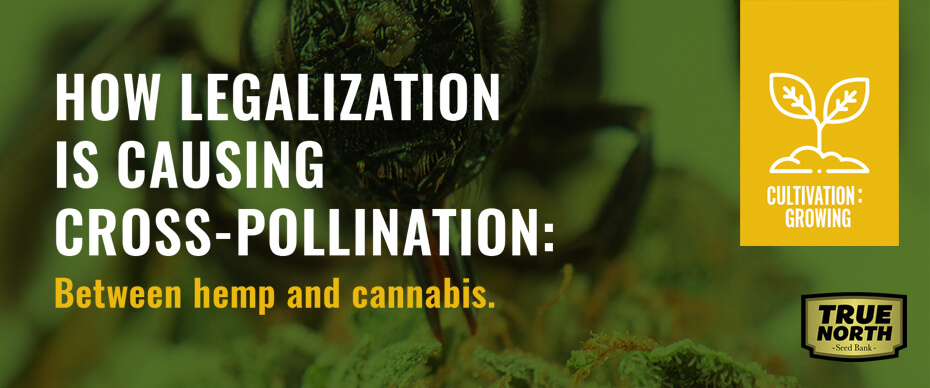
With widespread cannabis legalization, more farms have started growing both hemp and cannabis, causing an increase in the opportunity for cross-pollination between the two strains.
Legalization has led to pollen contamination between hemp and cannabis farms. This is common in outdoor farms growing both hemp and cannabis. Pollen from hemp travels freely to the cannabis plants in the air. This causes cannabis farms to yield weaker cannabis.
In this article, we analyzed research and scraped the web for information on cross-pollination. If you want to know more about the dangers of cross-pollination and how it happens, read on!
Are Hemp And Cannabis The Same Thing?
According to Cannabis and Cannabinoid Research, hemp and cannabis are not distinct species.
The only difference is that legally we label hemp as a cannabis plant with less than 0.3% THC.
This threshold of 0.3% was not established scientifically.
Instead, it was a definition proposed in 1979 in the book “The Species Problem In Cannabis.”
At the time, it was meant to separate cannabis strains that could get you high and those that could not.
This arbitrary number was then used in the “Agricultural Act. 2018” to distinguish between hemp and cannabis.
Scientific literature, for the most part, does not distinguish between cannabis and hemp as they are taxonomically identical.
Cannabis (or marijuana) is, therefore, hemp with more than 0.3% THC and is usually classified as Sativa, Indica, or hybrid.
Those three terms are colloquially used to denote some effects of cannabis where Sativa would provide a more uplifting effect.
Indica, on the other hand, would provide a more “mellow high” with couch locking effects.
While many people report that Sativa and Indica provide different effects, scientific experimentations are yet to be performed in order to confirm this hypothesis.
What Does Cross-pollination Imply?
Cross-pollination of hemp with cannabis implies that hemp growers living in places where cannabis is illegal could be charged with cannabis farming if the THC level is above 0.3%.
It also means that high potency cannabis growers might also have lower THC in their growth due to cross-pollination with hemp.
Cross-pollination may cause a female cannabis farm to start having some hermaphrodites or some male plants in their growth.
An increase in male plants will decrease the flowering yield of cannabis farmers and will likely produce weaker buds.
According to Small and Naraine (2016), cannabis is one of the few plant species capable of purposefully increasing the number and scale of its female sex organs in reaction to prolonged virginity.
Female plants that go longer without pollination develop more flowers and grow larger.
Female flower tissue contains a high concentration of cannabinoids, including the therapeutically essential THC and CBD.
(Meier et al.1998) discovered that pollination significantly decreased essential oil production in cannabis flowers.
Today, the majority of marijuana is sinsemilla (Spanish for "without seeds"), and seeded varieties are known to be poorer and thus sold for less capital.
The same technique is often used by farmers of industrial hemp that generates CBD.
Does Cross-pollination Provide Weaker Cannabis?
Yes, cross-pollination between hemp and cannabis breeds weaker strains for both types of farms.
It causes cannabis to have less THC and hemp to have less CBD.
Cross-pollination also increases the number of male plants in cannabis farms.
As we know, male plants do not flower buds and therefore present a lower yield to the cannabis farm.
Besides, the cannabis farm is likely to have less potent strains if it is cross-bred with hemp.
Beyond this, having cross-strain cannabis means that customers might not know what they will consume or what they pay for.
This might cause hemp farmers that grow medical buds to harvest a higher THC level which might be inadequate for medical use.
This was the cause behind the famous lawsuit of Oregon CBD.
Yet, cross-pollination can be incredibly hard to stop.
How To Avoid Cross-pollination
Cross-pollination could have unintended consequences that can irreversibly damage your plantation.
Here are the best cross-pollination prevention methods:
Roguing
Males can be eliminated by tracking plants and removing "escapes" as soon as they are detected.
Northeast Hemp Commodities urges consumers to use caution while dealing with hermaphroditic plants.
They will occur even though seeds are feminized.
If male and female plants are planted together, male plants usually develop pollen sacs a week to ten days before female flowers begin to bud.
Communication With Farmers Around You
Having good communication with farmers around you will make sure that you are aware of different grows happening.
You will therefore prepare in case of hemp pollen or cannabis pollen or discuss the different growing compromises with your farmer neighbour.
Stagger Planting
By growing hemp and cannabis at different times, you will reduce the chances of cross-contamination tremendously since the two types of pollen won’t linger in the air at the same time.
Have Isolation/No Pollen Zones
This can be done in three ways.
By either growing taller plants around your cannabis growth to prevent outside pollen from reaching the buds.
You may also create distance barriers since pollen can only travel up to 30 miles with 3-15 miles being most common.
And lastly, you may use HEPA (High-Efficiency Particulate Air) filters in your greenhouses to avoid pollen contamination.
How Is Legalization Causing Cross-pollination?
Since the start of the legalization campaign, we witnessed the appearance of home farmers.
Many of them proceeded into feminized and auto-flower seed breeding or even CBD hemp farming.
Some home growers even grow both CBD strains and cannabis strains in the same tent.
While this gave power to the people, it also allowed many unqualified growers to experiment and grow their own hybrids.
This led to the rise of cross-bred seeds which were sold as feminized or auto-flower seeds.
Besides, with the new legalization of cannabis, the price of cannabis has been on a steady decline, which encouraged farmers to cultivate on more acres of land, sometimes, too close to a hemp farm.

About the author: Joe Powers
After an incident in the military, in 2011, Joe Powers began investigating cannabis by talking with industry leaders. In 2016, Joe launched Hemp Writer with its first publication in clarifying disinformation on specific updates to certain federal CBD laws.
Upon calling out a leading cannabis law firm spreading dis-info, Hemp Writer established itself as an authority in clarifying updated information emerging from the cannabis industry. Joe continues charging forwards with increasing momentum to continue fulfilling his vision of SHARING ACCURATE CANNABIS INFORMATION.










